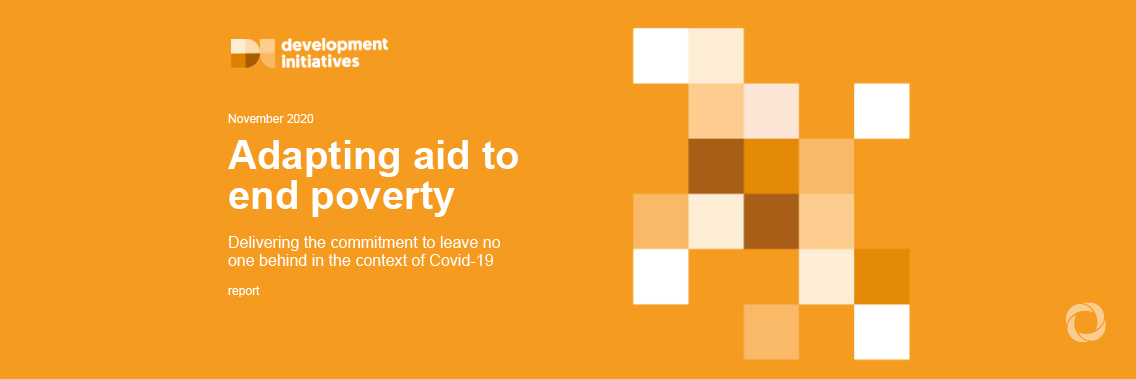The Covid-19 pandemic is having a devastating impact on human development around the world. In the short term, millions of people have lost their lives, livelihoods, incomes, and months of education. But the impacts are likely to reverberate for years, including on the education, job prospects, and the wellbeing of an entire generation. This is likely to impact the poorest people hardest – pushing some people even further behind. Official development assistance (ODA) is needed now more than ever, and it needs to support a recovery that is inclusive, sustained, and resilient.
Development Initiatives analysis of the data shows that despite warm words from donors and pledges to focus on the poorest people and places, patterns in ODA allocation have shifted little over time. Now is an opportune moment to reflect on how ODA might refocus to ensure it is most responsive to the immense harm caused by the Covid-19 pandemic, in both the short and long term, and reaches those that need it most.
The Covid-19 pandemic has increased the incidence of extreme income poverty in both low-income and middle-income countries. However, as the data shows, it is the poorest countries and fragile states that have fewer financial resources to emerge from this crisis quickly. ODA resources will be more important than ever before, and it is incumbent on the international donor community to ensure that ODA does not decline as a consequence of the crisis.
So how can ODA be most responsive to this new context? What does the data tell us? Addressing this crisis means addressing long-term challenges and imbalances in the allocation of ODA.
Where does ODA need to be strongly focused to leave no one behind?
The current pandemic, and the economic and social crises it has sparked, is exacerbating long-term challenges in development. The commitment to ‘leave no one behind’ is an ambitious one, but one that must be met. To do so, ODA needs to be refocused on the places and people that need it most, to close the gap between the poorest people and the rest of the world.
- In practical terms, this means accelerating ODA growth to the poorest countries, those facing the biggest financing challenges to meet the SDGs. Bilateral donors need to increase spending in these countries in line with historic commitments. While this is not a new recommendation, it remains an area where action is needed. Many of the countries identified as at risk of being left behind pre-Covid-19 are the same post-Covid-19; this is now even more urgent.
- International financial institutions (IFIs) and development finance institutions (DFIs) play an increasingly important role as providers of development finance and by channelling bilateral ODA resources, so it is important they strengthen their focus on the poorest and most marginalised.
Women have been particularly hard hit by the crisis and were already some of the people most at risk of being left behind. Strengthening gender-responsive ODA will have an outsized impact in the long and short term.
- Practically this means focusing more ODA on women, particularly those outside the formal economy.
- This is important for all actors, not just those in the ‘traditional’ aid community – IFIs, DFIs and other financial institutions should strengthen support to sectors and interventions that will have a positive impact on women.
What does ODA most need to focus on to leave no one behind?
Some investments will be particularly important not just to support human development but also to build the human capital and resilience to crises that will be key to sustained progress out of poverty. Over the medium term, investments in the core human capital areas of social protection, education, skills, and jobs will become more important than ever.
Investments in the climate and environment have, to date, not been central in ODA allocations to the world’s poorest places. Yet these investments are central to economic development, the health and wellbeing of communities, and long-term resilience, and they will have a high development impact in the poorest communities. The Covid-19 crisis has also exposed some countries’ vulnerabilities to models of growth dependent on natural resource extraction.
How does ODA need to be delivered to leave no one behind?
How aid is delivered is important and can strengthen countries’ ability to respond to the crisis and fund effective development in the longer term. The Covid-19 pandemic has increased uncertainty for the next few years, and countries will need to be much more adaptive and responsive to quickly manage changing circumstances and mitigate negative impacts. In that context, pre-existing trends of declining levels of concessionality in ODA and indications of declining bilateral ODA volumes, especially in the context of rising debt vulnerabilities, are a cause for concern. The shift towards finance from IFIs in the context of the Covid-19 response will further accentuate the shift towards loans.
Practically, this means that:
- Aid-delivery modalities that are flexible and allow for local decision-making on spending priorities will be more important than ever. Increasing the use of budget support and other flexible funding mechanisms where appropriate will be a vital part of a sustainable, locally owned, and effective recovery.
- Given that IFIs and other institutions will play a more important role, and that they will seek more resources to do so, they need to step up in providing more concessional resources targeted to the poorest countries and people. The major concerns about debt vulnerability strengthen the case for this step up.
Bilateral donors must reverse the trend of rising ODA loans, and less concessional forms of finance, particularly to the least developed countries (LDCs), to ensure that the risks of future debt crises are minimised. This is particularly important for the poorest countries and those that already have high debt burdens.
Read the report: Adapting aid to end poverty: Delivering the commitment to leave no one behind in the context of Covid-19.
Original source: Development Initiatives

